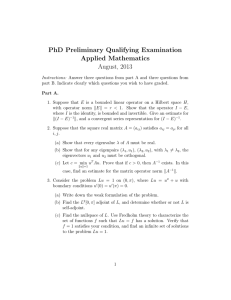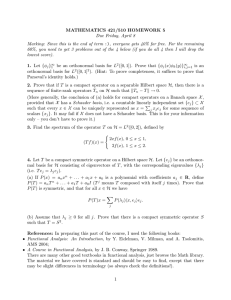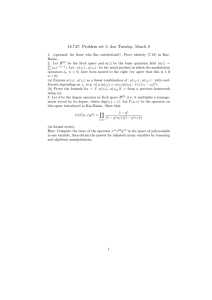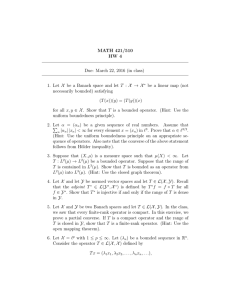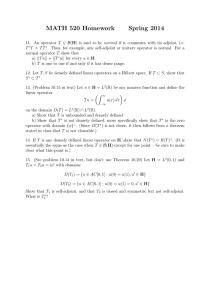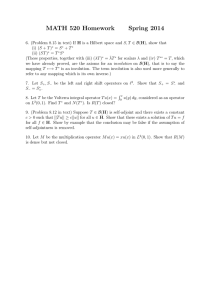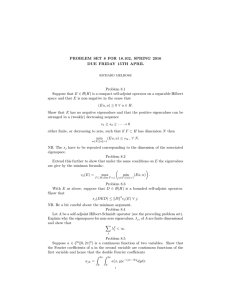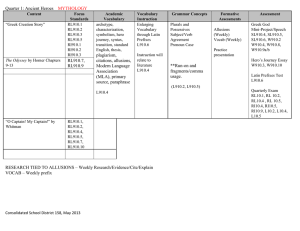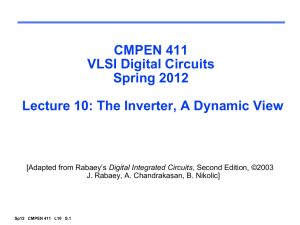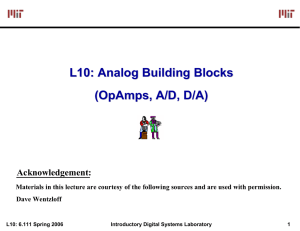PhD Preliminary Qualifying Examination Applied Mathematics
advertisement
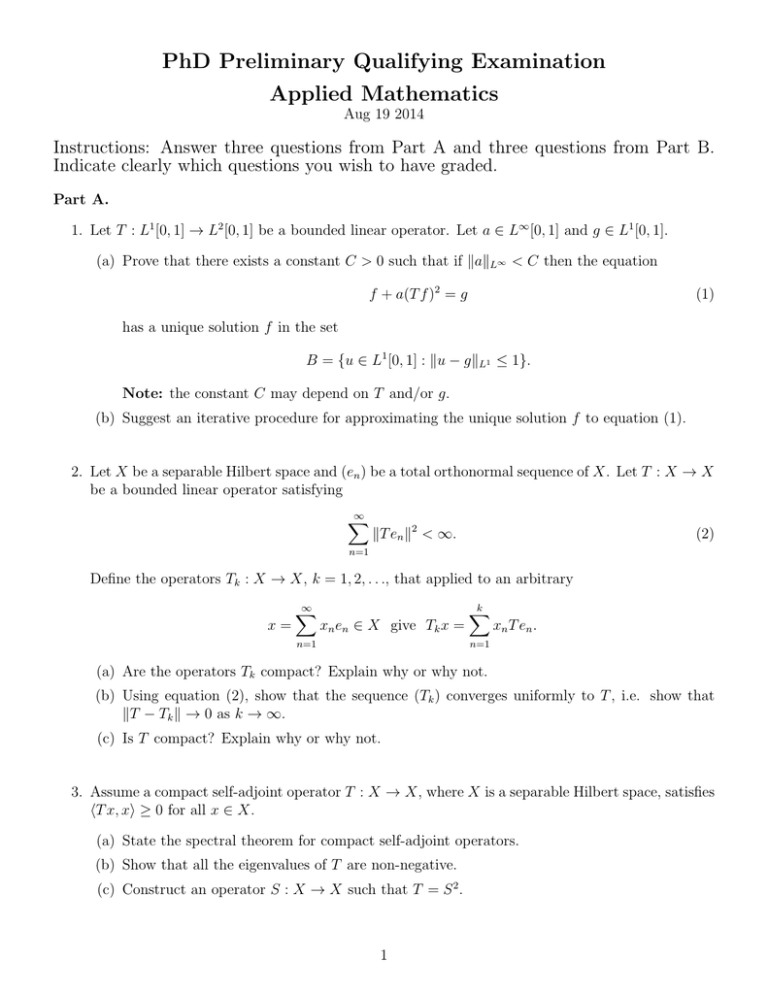
PhD Preliminary Qualifying Examination
Applied Mathematics
Aug 19 2014
Instructions: Answer three questions from Part A and three questions from Part B.
Indicate clearly which questions you wish to have graded.
Part A.
1. Let T : L1 [0, 1] → L2 [0, 1] be a bounded linear operator. Let a ∈ L∞ [0, 1] and g ∈ L1 [0, 1].
(a) Prove that there exists a constant C > 0 such that if kakL∞ < C then the equation
f + a(T f )2 = g
(1)
has a unique solution f in the set
B = {u ∈ L1 [0, 1] : ku − gkL1 ≤ 1}.
Note: the constant C may depend on T and/or g.
(b) Suggest an iterative procedure for approximating the unique solution f to equation (1).
2. Let X be a separable Hilbert space and (en ) be a total orthonormal sequence of X. Let T : X → X
be a bounded linear operator satisfying
∞
X
kT en k2 < ∞.
(2)
n=1
Define the operators Tk : X → X, k = 1, 2, . . ., that applied to an arbitrary
x=
∞
X
xn en ∈ X give Tk x =
k
X
xn T en .
n=1
n=1
(a) Are the operators Tk compact? Explain why or why not.
(b) Using equation (2), show that the sequence (Tk ) converges uniformly to T , i.e. show that
kT − Tk k → 0 as k → ∞.
(c) Is T compact? Explain why or why not.
3. Assume a compact self-adjoint operator T : X → X, where X is a separable Hilbert space, satisfies
hT x, xi ≥ 0 for all x ∈ X.
(a) State the spectral theorem for compact self-adjoint operators.
(b) Show that all the eigenvalues of T are non-negative.
(c) Construct an operator S : X → X such that T = S 2 .
1
4. Let l10 be the dual space of l1 . The objective here is to show that l10 is isomorphic to l∞ . You may
use that a Schauder basis for l1 (and l∞ ) is (ek ), where ek = (δkj ), i.e. the sequence with zeroes
everywhere except for a 1 in the k−th position.
(a) Show that any f ∈ l10 corresponds to a sequence g = (γk ) ∈ l∞ .
(b) Show that any sequence g = (γk ) ∈ l∞ corresponds to some f ∈ l10 .
(c) Parts (a) and (b) define a bijective linear mapping G : l10 → l∞ . Prove that G is an
isomorphism by showing kf kl10 = kG(f )kl∞ for any f ∈ l10 .
5. Let K : L2 [0, 1] → L2 [0, 1] be the linear operator defined by
Z 1
k(t, τ )x(τ )dτ
(Kx)(t) =
0
where k : [0, 1] × [0, 1] → R is continuous.
(a) Show that K is bounded and give an upper bound for kKk (in terms of k).
(b) Show that there is a constant C such that if |µ| < C, the operator I + µK is invertible.
(c) Assuming |µ| < C, where C is as in part (b), express (I + µK)−1 as a series. Specify whether
the series converges and in what sense.
2
Part B.
1. Find the radius of convergence of the Taylor series with the center at x0 = 1 for the following
function
(a)
f (x) = x1/3
(b)
f (z) =
(sin x + 2)2
(sin x − 2)2
(x is a real variable; you do not need to find the series themselves).
2. (a) Show that any analytic function (not identically equal to zero) can have only isolated zeros
inside its analyticity domain.
(b) Prove the Uniqueness Theorem: If two functions are analytic in a domain D and equal on
some set of points that has a limiting point inside D, then these functions are identically
equal in D.
3. Evaluate the integrals:
Z ∞
sin x
dx,
(a) I =
x
0
Z ∞ α
x
(b) I =
dx
2+x
0
(−1 < α < 0).
2
4. (a) Calculate the Fourier transform of a Gaussian f (x) = e−x .
(b) Formulate and prove Heisenberg’s uncertainty principle.
5. Consider integral
2
Z
I(s) =
C
es(z −1)
dz
z−1
with large parameter s → +∞; C is the vertical line Im z = 3, from z = 3 − i∞ to z = 3 + i∞.
(a) What is the saddle point z0 ?
What is the path C0 of steepest descent from z0 ?
What is the path of steepest ascent from z0 ?
(b) Find the three-term asymtotic expansion of the integral.
3
